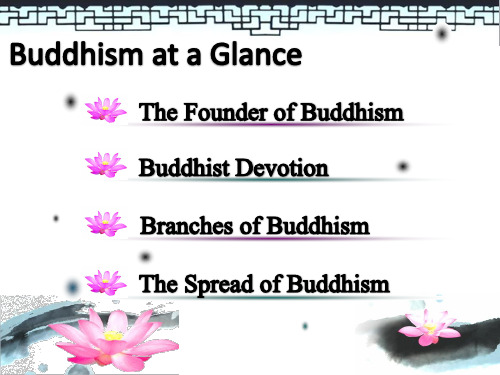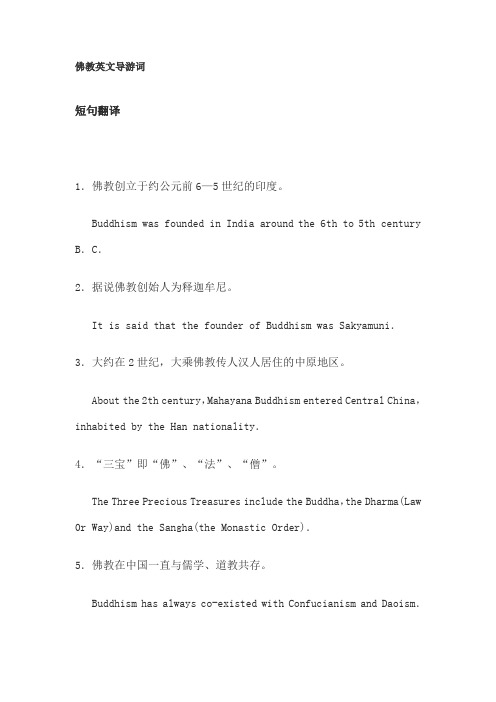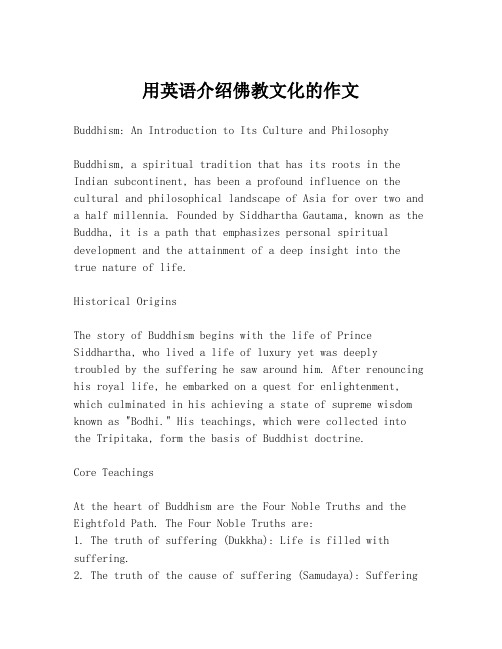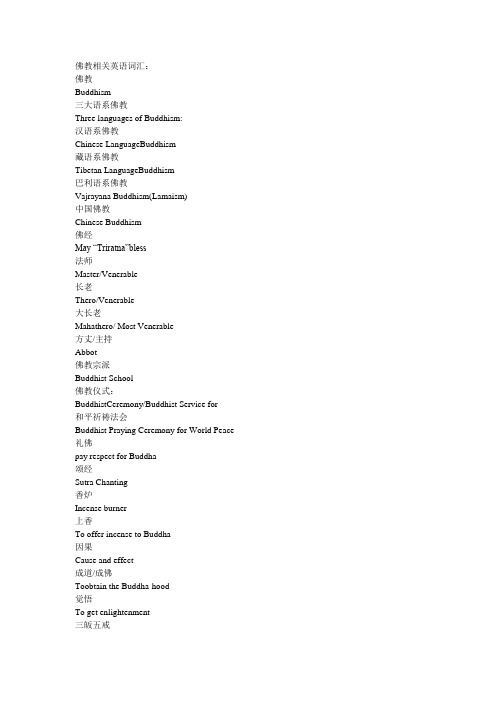佛教文化考古 英文
佛教概况 全英文介绍

---The Buddha. (佛宝)
Those who have attained Nirvana The Buddha could also be represented as a concept instead of a specific person: the perfect wisdom that understands Dharma and sees reality in its true form.
Two Major Branches
Theravada Mahayana
(the School of the Elders) (the Great Vehicle)
对佛的看法
修行目标
世界只有一佛
追求自我解脱 最高果位:罗汉 (重在利己)
十方世界都有佛
普渡众生以成佛 罗汉—菩萨—佛 (重在利他)
Buddha
Turning the dharmacakra 转法轮
Four Main Pilgrimage Sites
Lumbini: birthplace (in Nepal)
Bodh Gaya: the place of his Enlightenment
Sarnath: where he delivered his first teachibet and Mongolia, and Vajrayana adjacent parts of China and Russia
The route?
皈 依 三 宝
Tripitaka- “Three Baskets” “ 三藏”
《经藏》 《论藏》
《律藏》
Sutras
• mainly teachings and sermons of Buddha originally transcribed in Sanskrit or Pali • descriptions of Buddha and parables which may help lead to enlightenment of the reader
佛教英文导游词

佛教英文导游词短句翻译1.佛教创立于约公元前6—5世纪的印度。
Buddhism was founded in India around the 6th to5th century B.C.2.据说佛教创始人为释迦牟尼。
It is said that the founder of Buddhism was Sakyamuni.3.大约在2世纪,大乘佛教传人汉人居住的中原地区。
About the2th century,Mahayana Buddhism entered Central China,inhabited by the Han nationality.4.“三宝”即“佛”、“法”、“僧”。
The Three Precious Treasures include the Buddha,the Dharma(Law 0r Way)and the Sangha(the Monastic Order).5.佛教在中国一直与儒学、道教共存。
Buddhism has always co-existed with Confucianism and Daoism.6.佛像和菩萨雕塑供奉在寺院里,让人们拜祭。
Buddhism has and Bodhisattva statues have been placed for worship in monasteries.长句翻译7.直到现在,小乘佛教仍然流行于傣族地区。
Up to the present time.Hinayana Buddhism(Lesser Vehicle)is still prevalent as in the regions inhabited by Dai nationality.8.传统之间相互共存促进了有中国特色的宗教的形成。
Their mutual co-existence of the tradition has produced a religion with distinct Chinese characteristics.9.同一个寺院里除释迦牟尼以外,还供奉了许多其他佛像和菩萨雕塑。
佛教英文介绍

How helps?
A purpose to life
The injustice and inequality around the world A code of practice or way of life that leads to true happiness.
Who is Buddha?
Master Fa Xian (法显) the first Chinese monk traveler
Master Fa Xian and his companions reached 29 countries and brought back a huge mount of Buddhist classics from 399 – 412 (Eastern Jin Dynasty).
Siddhartha Gautama
a man who taught a path to enlightenment from his own experience
History
Origin Development
development
Pre-sectarian Buddhism : 6th B.C—— 4th B.C Early Buddhist schools : middle of 4th C —— middle of 1th C Early Mahayana Buddhism : middle of 1th C ——7th C Vajrayana (Esoteric Buddhism) : 7th C——12th C
The Song, Yuan, Ming Dynasty -- Chán grew to become the largest sect in Chinese, and the Chan school was firmly established The Qing Dynasty -- Tibetan Buddhism developed Modern times -- destroyed and then became popular again
介绍中国佛教的英语作文

Title: An Introduction to Buddhism in ChinaBuddhism, originating in ancient India, has woven itself into the fabric of Chinese culture and society over millennia, becoming an integral part of the nation's religious and philosophical landscape. This essay provides a brief overview of the introduction, development, and unique features of Buddhism in China.Origins and IntroductionBuddhism first arrived in China during the Han Dynasty (206 BCE – 220 CE), though its early influence was limited. It is believed that the first Buddhist scriptures were translated into Chinese by the monk An Shigao in the 2nd century CE, marking the official beginning of Buddhism's spread in the country. However, it was during the subsequent centuries, particularly during the Eastern Han and Wei-Jin periods, that Buddhism gained widespread acceptance among the elite and common people alike. Development and AssimilationAs Buddhism took root in China, it underwent significant transformations and assimilations, blending seamlessly with local Confucian and Taoist beliefs and practices. This process of Sinicization, or indigenization, gave rise to distinct Chinese Buddhist traditions that differ from their Indian origins. For instance, the development of Chan (Zen) Buddhism, with its emphasis on meditation and direct insight into one's true nature, is considered a uniquely Chinese contribution to the global Buddhist tradition.Major Schools and TraditionsOver time, several major Buddhist schools emerged in China, each with its unique teachings and practices. The Eight Great Schools of Early Buddhism, such as the Mahayana and Hinayana traditions, laid the foundation for later developments. Among the most influential are the Pure Land, Tiantai, and Chan (Zen) traditions. Pure Land Buddhism emphasizes faith in Amitabha Buddha and the aspiration for rebirth in his Pure Land. Tiantai, also known as the "Teaching of the One Vehicle," focuses on the interconnectedness of all phenomena and the unity of Buddhist teachings. Chan Buddhism, which originated in China and later spread to Japan and Korea, emphasizes meditation, direct insight, and the realization of one's innateBuddha-nature.Cultural ImpactBuddhism has had a profound impact on Chinese culture, art, architecture, literature, and philosophy. Buddhist temples and monasteries dot the Chinese landscape, serving as centers of religious practice, education, and cultural exchange. Buddhist art, characterized by intricate carvings, murals, and statues, has enriched the nation's artistic heritage. Moreover, Buddhist ideas and concepts have influenced Chineseliterature, particularly in the form of poetry and prose, where themes of enlightenment, impermanence, and compassion are frequently explored. ConclusionBuddhism in China is a testament to the resilience and adaptability of religious traditions as they traverse geographical and cultural boundaries. Through centuries of assimilation and innovation, Buddhism has become an inseparable part of Chinese identity, shaping the nation's spiritual landscape and contributing to its rich cultural heritage. Today, Buddhism continues to inspire millions of people in China and around the world, offering a path to enlightenment, peace, and harmony.。
佛教英语介绍

佛教BuddhismBuddhism is one of the world’s three major religions. It was founded by Siddhartha Gautama(悉达多乔达摩)who lived in the north-east region of the Indian subcontinent between 6BC and 5BC . Buddhism was widespread in many countries in Asia. During the Eastern Han Dynasty it was spread from the West to the East into China. Then as a result of the Buddhist influence on and mergence with Chinese culture, Buddhism came to be a natural part of Chinese civilization, albeit with a unique character. Buddhism has played an enormous role in shaping the mindset of the Chinese people,affecting our aesthetics , politics, literature, philosophy and medicine.Buddhist Immortals and Myths佛教形象和神话阿罗汉ArhatIt refers to those who have attained the goal of enlightenment or awakening and achieved nirvana (涅磐) without being reborn. The difference between an Arhat and a Buddha is that theBuddha attains enlightenment by himself, whereas the arhat does it by following the teachings of anther.阿弥陀佛Amitabha“Amitabha”is a Sanskrit world literally meaning boundless light and boundless life. He is the Buddha in the Land of Ultimate Bliss(极乐世界),in which all beings enjoy unbound happiness. According to the scriptures, Amitabha possesses infinite merit resulting from good deeds over countless past lives. He has forty-eight great vows to establish and adorn his Pure Land. People also recite or call upon his name by the time of dying, in the hope of being born in the Land of Ultimate Bliss with the reception by Amitabha. Amitabha is one of the most popular and well-known Buddha in China.阿弥陀佛1.jpg (241.09 KB, 下载次数: 0)。
用英语介绍佛教文化的作文

用英语介绍佛教文化的作文Buddhism: An Introduction to Its Culture and PhilosophyBuddhism, a spiritual tradition that has its roots in the Indian subcontinent, has been a profound influence on the cultural and philosophical landscape of Asia for over two and a half millennia. Founded by Siddhartha Gautama, known as the Buddha, it is a path that emphasizes personal spiritual development and the attainment of a deep insight into the true nature of life.Historical OriginsThe story of Buddhism begins with the life of Prince Siddhartha, who lived a life of luxury yet was deeply troubled by the suffering he saw around him. After renouncing his royal life, he embarked on a quest for enlightenment, which culminated in his achieving a state of supreme wisdom known as "Bodhi." His teachings, which were collected into the Tripitaka, form the basis of Buddhist doctrine.Core TeachingsAt the heart of Buddhism are the Four Noble Truths and the Eightfold Path. The Four Noble Truths are:1. The truth of suffering (Dukkha): Life is filled with suffering.2. The truth of the cause of suffering (Samudaya): Sufferingis caused by craving and attachment.3. The truth of the end of suffering (Nirodha): It ispossible to end suffering by overcoming craving and attachment.4. The truth of the path leading to the end of suffering (Magga): The Eightfold Path is the way to achieve this end.The Eightfold Path consists of right understanding, right intention, right speech, right action, right livelihood,right effort, right mindfulness, and right concentration. These practices are designed to help individuals achieve enlightenment and liberation from the cycle of rebirth knownas Samsara.Cultural ImpactBuddhism has had a significant impact on the arts, literature, and daily life in countries such as India, China, Japan, Thailand, and many others. Buddhist art, including statues of the Buddha, mandalas, and thangka paintings, often serve as a focus for meditation and are rich in symbolic meaning. Buddhist literature encompasses a vast array of texts, fromthe sutras to the philosophical treatises of various schoolsof thought.Meditation and MindfulnessCentral to Buddhist practice is meditation, which is seen asa means to calm the mind and gain insight into the nature of reality. Mindfulness, a concept that has gained popularity in the West, originates from Buddhist teachings and involvespaying close attention to the present moment without judgment.Buddhism TodayToday, Buddhism continues to evolve and adapt to modern society. It has spread beyond its Asian origins to become a global religion with millions of followers. The teachings of Buddhism offer a path to inner peace and ethical living that resonates with many in a world that is often chaotic and stressful.In conclusion, Buddhism is not just a religion but a way oflife that has provided countless individuals with a framework for understanding the world and for achieving personal transformation. Its teachings on compassion, wisdom, and the interconnectedness of all beings continue to inspire andguide those who seek a deeper understanding of life's complexities.。
莫高窟文化遗产英语作文

莫高窟文化遗产英语作文Title: The Cultural Heritage of the Mogao Caves。
The Mogao Caves, also known as the Thousand Buddha Grottoes, represent a treasure trove of Buddhist art and culture in China. Situated near the oasis town of Dunhuang, in Gansu Province, these caves have a rich history dating back over a millennium. This essay delves into the significance of the Mogao Caves as a cultural heritage site.First and foremost, the Mogao Caves are renowned for their exceptional collection of Buddhist art spanning overa thousand years. These caves, carved into the cliffs along the ancient Silk Road, house thousands of murals, sculptures, and manuscripts. The art within the caves reflects the evolution of Buddhist iconography and artistic styles over the centuries, providing invaluable insightsinto the religious, cultural, and artistic practices of ancient China.Moreover, the Mogao Caves serve as a testament to the cross-cultural exchange facilitated by the Silk Road. As a vital hub along this ancient trade route, Dunhuang was a melting pot of diverse cultures and religions, including Buddhism, Daoism, and Islam. The art found in the Mogao Caves bears witness to this cultural fusion, incorporating elements from Central Asia, India, and China. This cultural synthesis not only enriched the artistic repertoire of the region but also fostered mutual understanding and tolerance among different communities.Furthermore, the Mogao Caves played a pivotal role in the transmission of Buddhist scriptures and teachings. The discovery of the Dunhuang manuscripts, a vast collection of Buddhist texts, literary works, and administrative documents, shed light on the intellectual and religiouslife of medieval China. These manuscripts, hidden within the caves for centuries, provide invaluable insights into the beliefs, rituals, and everyday practices of ancient Chinese society.In addition to their artistic and historicalsignificance, the Mogao Caves hold immense spiritual importance for Buddhists around the world. Pilgrims and devotees visit these sacred sites to pay homage to the Buddha and seek spiritual enlightenment. The serene atmosphere of the caves, coupled with the awe-inspiring beauty of the murals and statues, creates a sense of reverence and tranquility that transcends time and space.However, despite their cultural significance, the Mogao Caves face numerous challenges, including environmental degradation, natural disasters, and human activities. Climate change, in particular, poses a significant threat to the preservation of the caves and their priceless treasures. Rising temperatures, increased humidity, and sandstorms accelerate the deterioration of the fragile murals and sculptures, jeopardizing their long-term survival.To address these challenges, concerted efforts are underway to conserve and protect the Mogao Caves and their cultural heritage. Conservation experts employ advanced techniques and technologies to stabilize the cavestructures, monitor environmental conditions, and prevent further deterioration of the artworks. Furthermore, initiatives aimed at raising awareness and promoting sustainable tourism seek to balance the preservation of the site with the needs of visitors and local communities.In conclusion, the Mogao Caves stand as a testament to the rich cultural heritage of China and the enduring legacy of Buddhist civilization. As custodians of this priceless treasure, it is our collective responsibility to safeguard the caves and ensure that future generations can continue to marvel at their beauty and significance. Through preservation, research, and education, we can ensure that the legacy of the Mogao Caves remains alive for centuries to come.。
佛教相关英语词汇

佛教相关英语词汇:佛教Buddhism三大语系佛教Three languages of Buddhism:汉语系佛教Chinese LanguageBuddhism藏语系佛教Tibetan LanguageBuddhism巴利语系佛教Vajrayana Buddhism(Lamaism)中国佛教Chinese Buddhism佛经May “Triratna”bless法师Master/Venerable长老Thero/Venerable大长老Mahathero/ Most Venerable方丈/主持Abbot佛教宗派Buddhist School佛教仪式:BuddhistCeremony/Buddhist Service for和平祈祷法会Buddhist Praying Ceremony for World Peace 礼佛pay respect for Buddha颂经Sutra Chanting香炉Incense burner上香To offer incense to Buddha因果Cause and effect成道/成佛Toobtain the Buddha-hood觉悟To get enlightenment三皈五戒The ceremony for lay Buddhists to go to the Buddha for refuge, goto the Dharma for refuge, go to the Sangha forrefuge and to follow the five commandments of Buddhism(no killing,no stealing,no sexualmisconduct,no lying,no intoxicant)诸恶莫做,众善奉行,自净其意,既是佛教“To do no evil, to do only good, to purify the will, is thedoctrine of all Buddhas”做功德To make contribution to普渡终生To save all living beings from sufferingsAmitabha 阿弥陀佛Avalokiteshvara 观音Bhodisattva 菩萨释迦牟尼佛Buddha Sakyamuni观音菩萨AvalOkiteSVaraffinities 因缘* (with emphasis on good relationships)All living beings have the Buddha-nature; all can become Buddhas. 一切众生,皆有佛性,皆堪作佛。
- 1、下载文档前请自行甄别文档内容的完整性,平台不提供额外的编辑、内容补充、找答案等附加服务。
- 2、"仅部分预览"的文档,不可在线预览部分如存在完整性等问题,可反馈申请退款(可完整预览的文档不适用该条件!)。
- 3、如文档侵犯您的权益,请联系客服反馈,我们会尽快为您处理(人工客服工作时间:9:00-18:30)。
Mahāyānika Golayantritasri Gautama Sripada
Southeast Asia in 430 CE
Kedah inscription, 5th century
Yijing 635-713 A.D. Travelled over 30 countries in 20 years collecting over 500,000 Buddhist verses. Translated 61 scriptures.
Xi’an: (Chang-an) Big Wild
Goose; Small Wild Goose Qing Long Si: master and disciple bid farewell
Nalanda copper-plate, mid-9th century:
There was a king of Yavabhumi who was the ornament of the Sailendra dynasty. He had a son, who possessed prudence, prowess, and good conduct... He was the foremost warrior in battle-fields and his fame was equal to that earned by Yudhishthira, Parasara, Bhisena, and Arjuna. Tara was the queen consort of that king, the illustrious Balaputra. With the mind attracted by the manifold excellences of Nalanda and through devotion to the son of Suddhodana (i.e. the Buddha) and having realised that riches are fickle like the waves of a mountain stream, he … built there a monastery which was the abode of the assembly of monks of various good qualities and was white with the series of stuccoed and lofty dwellings.
Buddhist Archaeology and the ISEAS Archaeological Unit
Buddhism came to Southeast Asia almost 2,000 years ago. Chinese pilgrims such as Faxian in the fifth century and Yijing in the late 7th century travelled between China and the holy places of Buddhism in northeast India by sea, through Southeast Asia. They travelled on merchant ships, and stayed in major ports such as Srivijaya and Malayu, where they saw large monasteries. Historical records on early Buddhism in Southeast Asia are very scarce. Archaeological materials for the study of early Southeast Asian Buddhism are much more common, and include huge quantities of Buddhist sculpture and architecture from Burma (Myanmar), Java, and Sumatra. Singapore in the 14th century was also a Buddhist kingdom, and was an important seaport for a century before the foundation of Melaka.
Borobudur
Nalanda
Xi’an
• The ISEAS Archaeological Unit will form part of the NalandaSriwijaya Centre. • Research Projects: Early Buddhist sites in Myanmar, Indonesia, and Singapore. • Study of the spread of early Buddhism along maritime trade routes. • The Archaeological Laboratory at NUS . • Displays on Buddhist archaeology at ISEAS. • A Modern Buddhist Monument: a book on the Buddhist Lodge.
Sri Tri Buana goes to Temasek and founds a city which he names Singapura.
1825 map of Singapore, depicting the Malay Wall, probably a 14thcentury fortification
The Malay Annals and the Founding of Singapore
The twtang Mahameru, Palembang.
The young prince Sang Nila Utama becomes ruler with the title Sri Tri Buana.
